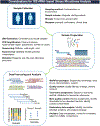Community profiling of the urinary microbiota: considerations for low-biomass samples
- PMID: 30315209
- PMCID: PMC6352978
- DOI: 10.1038/s41585-018-0104-z
Community profiling of the urinary microbiota: considerations for low-biomass samples
Abstract
Many studies have shown that the urinary tract harbours its own microbial community known as the urinary microbiota, which have been implicated in urinary tract disorders. This observation contradicts the long-held notion that urine is a sterile biofluid in the absence of acute infection of the urinary tract. In light of this new discovery, many basic questions that are crucial for understanding the role of the urinary microbiota in human health and disease remain unanswered. Given that the urinary microbiota is an emerging area of study, optimized techniques and protocols to identify microorganisms in the urinary tract are still being established. However, the low microbial biomass and close proximity to higher microbial biomass environments (for example, the vagina) present distinct methodological challenges for microbial community profiling of the urinary microbiota. A clear understanding of the unique technical considerations for obtaining and analysing low microbial biomass samples, as well the influence of key elements of experimental design and computational analysis on downstream interpretation, will improve our ability to interpret and compare results across methods and studies and is relevant for studies profiling the urinary microbiota and other sites of low microbial abundance.
Figures



References
-
- Fouts DE, Pieper R, Szpakowski S, Pohl H, Knoblach S, Suh M-J, Huang S-T, Ljungberg I, Sprague B, Lucas SK, Torralba M, Nelson KE & Groah SL Integrated next-generation sequencing of 16S rDNA and metaproteomics differentiate the healthy urine microbiome from asymptomatic bacteriuria in neuropathic bladder associated with spinal cord injury. J. Transl. Med 10, 174 (2012). - PMC - PubMed
-
- Pearce MM, Zilliox MJ, Rosenfeld AB, Thomas-White KJ, Richter HE, Nager CW, Visco AG, Nygaard IE, Barber MD, Schaffer J, Moalli P, Sung VW, Smith AL, Rogers R, Nolen TL, Wallace D, Meikle SF, Gai X, Wolfe AJ & Brubaker L The female urinary microbiome in urgency urinary incontinence. Am. J. Obstet. Gynecol 213, 347.e1–11 (2015). - PMC - PubMed
Publication types
MeSH terms
Grants and funding
- R01 EY029266/EY/NEI NIH HHS/United States
- UL1 TR002369/TR/NCATS NIH HHS/United States
- R01 MH105538/MH/NIMH NIH HHS/United States
- K01 DK116706/DK/NIDDK NIH HHS/United States
- P30 CA016042/CA/NCI NIH HHS/United States
- R01 MH096773/MH/NIMH NIH HHS/United States
- U24 TR002306/TR/NCATS NIH HHS/United States
- R00 MH091238/MH/NIMH NIH HHS/United States
- K12 HD043488/HD/NICHD NIH HHS/United States
- R01 MH115357/MH/NIMH NIH HHS/United States
- P01 DK046763/DK/NIDDK NIH HHS/United States
- UL1 TR001881/TR/NCATS NIH HHS/United States
LinkOut - more resources
Full Text Sources

